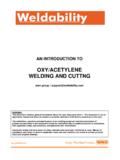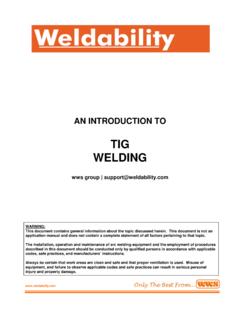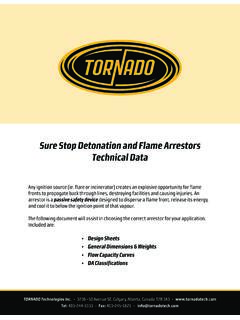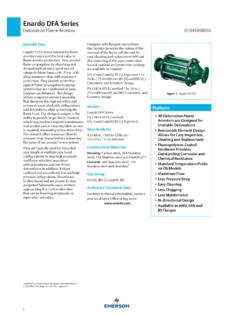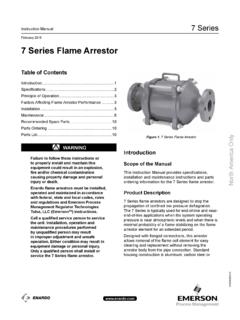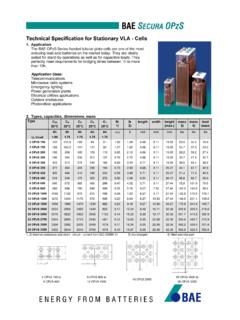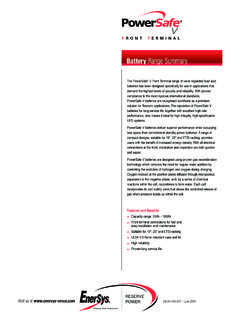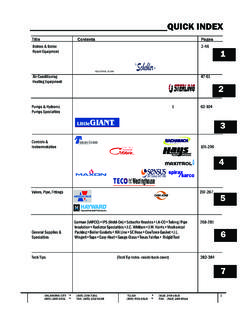Transcription of OXY/ACETYLENE WELDING AND CUTTNG - Weldability Sif
1 AN INTRODUCTION TO OXY/ACETYLENE WELDING AND CUTTNG wws group | WARNING: This document contains general information about the topic discussed herein. This document is not an application manual and does not contain a complete statement of all factors pertaining to that topic. The installation, operation and maintenance of arc WELDING equipment and the employment of procedures described in this document should be conducted only by qualified persons in accordance with applicable codes, safe practices, and manufacturers instructions. Always be certain that work areas are clean and safe and that proper ventilation is used. Misuse of equipment, and failure to observe applicable codes and safe practices can result in serious personal injury and property damage.
2 | page 2 of 13 Introduction Oxygen/ acetylene WELDING , or Gas WELDING , is a process which relies on combustion of oxygen and acetylene . When mixed together in correct proportions within a hand-held torch or blowpipe, a hot flame is produced with a temperature of about 3,200 C. The chemical action of the OXY/ACETYLENE flame can be adjusted by changing the ratio of the volume of oxygen to acetylene , using the valves on the torch or blowpipe. Equipment OXY/ACETYLENE equipment is portable and easy to use. It comprises oxygen and acetylene gases stored under pressure in steel cylinders. The cylinders should be fitted with regulators, to control the pressure and flow of gases. Flexible hoses are used to connect the regulators to the torch or blowpipe.
3 Specially designed safety devices, called flame traps or Flashback Arrestors are fitted between the hoses and the regulators. Flashback arrestors prevent flames generated by a 'flashback' from reaching the cylinders Flashbacks A flashback is a rapid, high-pressure flame travelling back up the gas hoses, caused by WELDING or cutting at incorrect pressure settings, or from blockage or overheating of the nozzle (for example by operating with the nozzle too close to the material) Flashbacks can result in extremely dangerous cylinder ignition and must be prevented by proper use of working Flashback Arrestors. Lighting-Up Procedure To begin oxygen/ acetylene WELDING or cutting, open the cylinder valves slowly by means of the cylinder key(s). Do not open suddenly or there may be serious damage to the regulator and the possibility of an accident.
4 Open the cylinder valve spindles one turn only. Open the fuel gas control valve on the blowpipe and adjust the regulator to give the correct working pressure (see chart on page 13), this ensures that any air or oxygen is purged from the hose. Repeat the procedure for the oxygen side. Light the gas by means of a suitable sparklighter making sure that the sparklighter is held at right angles to the nozzle. Do not use liquid igniters (such as cigarette lighters) as the vapour/gas combination can be dangerous. Reduce or increase the acetylene supply to the blowpipe valve until the flame just ceases to smoke. Slowly increase the oxygen via the blowpipe control valve until the white inner cone in the flame is sharply defined with the merest trace of an acetylene haze.
5 The blowpipe is now correctly adjusted. Fig. 1 OXY/ACETYLENE Equipment | page 3 of 13 WELDING TECHNIQUES Leftward WELDING Leftward WELDING is used on steel for flanged edge welds, for unbevelled plates up to (3/16in). It is also the method usually adopted for cast iron and non-ferrous metals. WELDING is started at the right-hand end of the joint and proceeds towards the left. Fig. 2 Leftward WELDING The blowpipe is given a forward motion with a slight sideways movement to maintain melting of the edges of both plates at the desired rate and the WELDING rod is moved progressively along the weld seam see fig. 2. The sideways motion of the blowpipe should be restricted to a minimum. Rightward and all position rightward WELDING Rightward WELDING is recommended for steel plate over (3/16in) thick.
6 Plates from to (3/16in to 5/16in) need not be bevelled; over (5/16in) the edges are bevelled to 30o to give an included angle of 60o for the WELDING V. Suitable for horizontal/vertical position. Fig. 3 Rightward WELDING The weld is started at the left-hand end and moves towards the right with the blowpipe flame preceding the filler rod in the direction of travel. The rod is given a circular forward motion and the blowpipe is moved steadily along the weld seam See Fig. 3 This is faster than leftward WELDING and consumes less gas; the V angle is smaller, less filler rod is used and there is less distortion. The all-position rightward technique is a modification of the above and is particularly suitable for mild steel plate and pipe in the vertical and overhead position See Fig.
7 4 on page 4. | page 4 of 13 Fig. 4 All-position rightward WELDING . Butt-welds in mild 5 - 8mm (3/16 - 5/16in) thick. | page 5 of 13 The advantages are that it enables the welder to obtain a uniform penetration bead and an even build-up, particularly in fixed position WELDING ; the welder can work with complete freedom of movement and has a clear view of the weld pool and the fusion zone of the joint. Considerable practice is required to become familiar with this technique even by operators skilled in normal downhand rightward WELDING . An apparent undercutting of the plate surface at the edges of the weld bead is a fault to which this technique is prone but this can be controlled by appropriate manipulation of the rod and flame.
8 The rod and blowpipe angle should be adjusted to give adequate control of the molten metal as in normal rightward WELDING . Fig. 5 Vertical WELDING , single-operator for plate thicknesses up to (3/16in) | page 6 of 13 Vertical WELDING Vertical WELDING may be used on unbevelled steel plate up to 3mm (1/8in) thickness and up to 15mm (5/8in) when two welders are employed working on both sides of the joint; WELDING starts at the bottom and proceeds vertically. See Fig. 5 and 6 for methods of blowpipe and WELDING rod manipulation for single-operator techniques. When the two-operator method is used, the two welders must be trained to work in harmony. Vertical WELDING , two operators for plates thicker than (3/16in) | page 7 of 13 Fig.
9 7 Edge preparations | page 8 of 13 Bronze WELDING Bronze WELDING involves the use of alloy bronze rods and is used for making joints in copper, for joining dissimilar metals, and for repairs to cast iron. Among the rods used are fluxobronze, a flux-coated silicon bronze, plain silicon bronze, plain nickel bronze and manganese bronze with suitable flux. It is essential that the edges of the materials should not be melted but merely raised to red heat. For example when bronzewelding cast iron, a manganese bronze rod should be used; this melts at 895 C, well below the melting point of cast iron. The fracture, or the edges of the metal to be joined are prepared in the usual manner, care being taken to ensure that all sharp edges are rounded-off and that they are absolutely clean.
10 The joint so formed has excellent mechanical properties and providing there is no objection to dissimilarity in colour, bronzewelding can be recommended for a variety of purposes. Fractured castings should be pre-heated before WELDING . Depositing Hardfacing Rods This is a process which consists of laying down a hard deposit which is very resistant to wear on a steel or cast iron surface and finds wide application in building-up wearing services on well-boring drills, dies, picks, valve seats, punches, knives, crushing and excavating machinery, etc. For steel, the flame is adjusted to an excess of acetylene to give a feather of 1 to 2 times the length of the normal neutral inner cone. The steel is raised to a dull red-heat and when the surface begins to sweat the rod is deposited on the surface see Fig.
